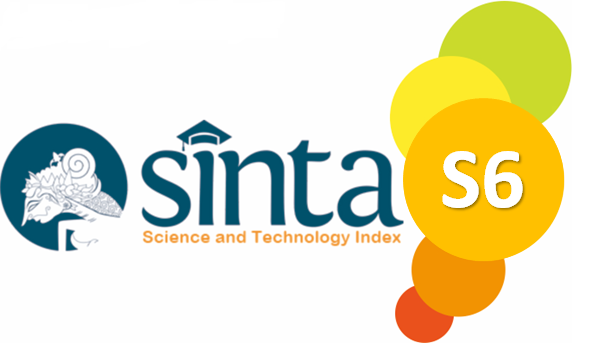AN ANALYSIS OF HIGHER ORDER THINKING SKILL QUESTIONS IN READING COMPREHENSION IN SCHOOL FINAL EXAMINATION IN BIMA
Keywords:
Higher order thinking skill, lower order thinking skill, reading comprehension, school final examination
Abstract
This study is aimed at finding out the distribution of higher order thinking skill questions, describing the specific cognitive processes demonstrated under HOTS questions, and finding out the portion of HOTS questions in two school examination packages in Bima. Content analysis was used to examine 86 reading comprehension test items in school final examination using Bloom’s taxonomy revised version. Qualitative data analysis was applied to the reading comprehension question items. Public documentation, indirect observation and a semi-structured interview were performed to collect the data. Data source were collected from reading comprehension test items and analysis card. In analyzing the data, qualitative analysis of Miles, Huberman, & Saldana (2014) model with three phases was applied. The findings indicated the distribution of higher order thinking skill questions are lower than lower order thinking skill questions. HOTS only obtain 6 out of 86 questions while the rest of questions are indicated as LOTS. Analyze skill has the highest distribution among HOTS skills: 4 questions, evaluate skill has 2 questions, while create skill is not found. On the contrary, the most used specific cognitive processes in the whole questions are interpreting and recognizing skill with the frequency of 18 questions, and differentiating and critiquing skills frequently appear in the test as the specific cognitive processes of HOTS questionsReferences
Anasy, Z. (2016). Hots (Higher Order Thinking Skill) in reading exercise. TARBIYA: Journal of Education in Muslim Society, 3(1), 51–63. https://doi.org/10.15408/tjems.v3i1.3886
Anderson, L. W., Krathwohl Peter W Airasian, D. R., Cruikshank, K. A., Mayer, R. E., Pintrich, P. R., Raths, J., & Wittrock, M. C. (2001). Taxonomy for learning, teaching, and assessing: A revision of Bloom’s taxonomy of educational objectives (B. Allyn, Ed.). Retrieved from https://www.uky.edu/~rsand1/china2018/texts/Anderson-Krathwohl - A taxonomy for learning teaching and assessing.pdf
Bloom, B. S. (1956). Taxonomy of education objectives. 207. Retrieved from https://www.uky.edu/~rsand1/china2018/texts/Bloom et al -Taxonomy of Educational Objectives.pdf
Brookhart, S. M. (2010). How to assess higher-order thinking skills in your classroom. ASCD.
Ciesielska, M., & Jemielniak, D. (2017). Qualitative methodologies in organization studies. Qualitative Methodologies in Organization Studies, 2(December), 1–264. https://doi.org/10.1007/978-3-319-65442-3
Creswell, J. W. (2014). Research Design Qualitative Quantitative and Mixed Methods Approaches. https://doi.org/10.1007/s13398-014-0173-7.2
Denzin, N. K., & Lincoln, Y. S. (2000). Introduction: The discipline and practice of qualitative research. In Handbook of qualitative research (2nd edition).
Fahim, M., & Masouleh, N. S. (2012). Critical thinking in higher education: A pedagogical look. Theory and Practice in Language Studies, 2(7). https://doi.org/10.4304/tpls.2.7.1370-1375
Febrina, Usman, B., & Muslem, A. (2019). Analysis of reading comprehension questions by using revised Bloom’s taxonomy on higher order thinking skill (HOTS). English Education Journal: Jurnal Pengembangan Pendidikan Dan Pengembangan Pengajaran Bahasa, 10(1), 1–15.
Griffee, D. T. (2012). An Introduction to Second Language Research Methods: Design and Data. Berkeley: TESL-EJ Publications.
Hsieh, H. F., & Shannon, S. E. (2005). Three approaches to qualitative content analysis. Qualitative Health Research, 15(9), 1277–1288. https://doi.org/10.1177/1049732305276687
Huang, L. (2010). Reading aloud in the foreign language teaching. Journal of Asian Social Science, Vol 6, No., 148–150.
Keshta, A. S., & Seif, A. (2013). Evaluating the higher order thinking skills in reading of English for Palestine grade eight. Asian Journal of Education and E-Learning, 01(01), 2321–2454. Retrieved from www.ajouronline.com
Krathwohl, D. R. (2000). Use these notes and the other reference info. New York Longman, Complete e(4), 302. https://doi.org/10.1207/s15430421tip4104_2
Miles, M. B., Huberman, M. a, & Saldana, J. (2014). Drawing and verying conclusions. Qualitative Data Analysis: A Methods Sourcebook. https://doi.org/January 11, 2016
Moore, B., & Stanley, T. (2013). Critical thinking and formative assessments: Increasing the rigor in your classroom. https://doi.org/10.4324/9781315856261
Penelitian, P., Pendidikan, K., & Kebudayaan, D. A. N. (2018). Muatan HOTS pada pembelajaran kurikulum 2013 pendidikan dasar.
Putra, T. K., & Abdullah, D. F. (2019). Higher-order thinking skill (Hots) questions in English national examination in Indonesia. Jurnal Bahasa Lingua Scientia, 11(1), 145–160. https://doi.org/10.21274/ls.2019.11.1.145-160
Raiyn, J., & Tilchin, O. (2017). A model for assessing the development of HOT skills in students. American Journal of Educational Research, 5(2), 184–188. https://doi.org/10.12691/education-5-2-12
Retnawati, H., Djidu, H., Kartianom, K., Apino, E., & Anazifa, R. D. (2018). Teachers’ knowledge about higher-order thinking skills and. Problem of Education in The 21st Century, 76(2), 215–230.
Shank, G. D. (2006). Qualitative research: A personal skills approach.
Thompson, T. (2008). Mathematics teachers’ interpretation of higher-order thinking in Bloom’s taxonomy. International Electronic Journal of Mathematics Education.
Valdev Singh, R. K., & Shaari, A. H. (2019). The analysis of Higher-Order Thinking skills in English reading comprehension tests in Malaysia. Malaysian Journal of Society and Space, 15(01). https://doi.org/10.17576/geo-2019-1501-02
Wilson, L. O. (2016). Anderson and Krathwohl – Bloom’s Taxonomy Revised URL: The Second Principle, 1–8. Retrieved from https://thesecondprinciple.com/teaching-essentials/beyond-bloom-cognitive-taxonomy-revised/%0
Zhang, Y., & Wildemuth, B. M. (2009). Qualitative analysis of content. Applications of Social Research Methods to Questions in Information and Library Science. https://doi.org/10.1002/hbm.20661
Online sources
Azmah, Roifah. (2019, December 13). JK tak satu suara dengan Nadiem soal UN diganti. Retrieved from https://papua.tribunnews.com
Agus, Utantoro (2019, December 13). Soal HOTS di UN SMP sudah disesuaikan. Retrieved from https://mediaindonesia.com
Ibrahim, Gufran (2019, December 15). PISA dan daya baca bangsa. Retrieved from https://kompas.com
Yulaika, Ramadhani (2019, December 15). Mendikbud: Hasil UN SMP alami penurunan karena soal HOTS. Retrieved from https://tirto.id/cK3D
Richards, J,C. (2019 December 17). Difference between task, exercise, activity. Retrieved from https://www.professorjackrichards.com
Anderson, L. W., Krathwohl Peter W Airasian, D. R., Cruikshank, K. A., Mayer, R. E., Pintrich, P. R., Raths, J., & Wittrock, M. C. (2001). Taxonomy for learning, teaching, and assessing: A revision of Bloom’s taxonomy of educational objectives (B. Allyn, Ed.). Retrieved from https://www.uky.edu/~rsand1/china2018/texts/Anderson-Krathwohl - A taxonomy for learning teaching and assessing.pdf
Bloom, B. S. (1956). Taxonomy of education objectives. 207. Retrieved from https://www.uky.edu/~rsand1/china2018/texts/Bloom et al -Taxonomy of Educational Objectives.pdf
Brookhart, S. M. (2010). How to assess higher-order thinking skills in your classroom. ASCD.
Ciesielska, M., & Jemielniak, D. (2017). Qualitative methodologies in organization studies. Qualitative Methodologies in Organization Studies, 2(December), 1–264. https://doi.org/10.1007/978-3-319-65442-3
Creswell, J. W. (2014). Research Design Qualitative Quantitative and Mixed Methods Approaches. https://doi.org/10.1007/s13398-014-0173-7.2
Denzin, N. K., & Lincoln, Y. S. (2000). Introduction: The discipline and practice of qualitative research. In Handbook of qualitative research (2nd edition).
Fahim, M., & Masouleh, N. S. (2012). Critical thinking in higher education: A pedagogical look. Theory and Practice in Language Studies, 2(7). https://doi.org/10.4304/tpls.2.7.1370-1375
Febrina, Usman, B., & Muslem, A. (2019). Analysis of reading comprehension questions by using revised Bloom’s taxonomy on higher order thinking skill (HOTS). English Education Journal: Jurnal Pengembangan Pendidikan Dan Pengembangan Pengajaran Bahasa, 10(1), 1–15.
Griffee, D. T. (2012). An Introduction to Second Language Research Methods: Design and Data. Berkeley: TESL-EJ Publications.
Hsieh, H. F., & Shannon, S. E. (2005). Three approaches to qualitative content analysis. Qualitative Health Research, 15(9), 1277–1288. https://doi.org/10.1177/1049732305276687
Huang, L. (2010). Reading aloud in the foreign language teaching. Journal of Asian Social Science, Vol 6, No., 148–150.
Keshta, A. S., & Seif, A. (2013). Evaluating the higher order thinking skills in reading of English for Palestine grade eight. Asian Journal of Education and E-Learning, 01(01), 2321–2454. Retrieved from www.ajouronline.com
Krathwohl, D. R. (2000). Use these notes and the other reference info. New York Longman, Complete e(4), 302. https://doi.org/10.1207/s15430421tip4104_2
Miles, M. B., Huberman, M. a, & Saldana, J. (2014). Drawing and verying conclusions. Qualitative Data Analysis: A Methods Sourcebook. https://doi.org/January 11, 2016
Moore, B., & Stanley, T. (2013). Critical thinking and formative assessments: Increasing the rigor in your classroom. https://doi.org/10.4324/9781315856261
Penelitian, P., Pendidikan, K., & Kebudayaan, D. A. N. (2018). Muatan HOTS pada pembelajaran kurikulum 2013 pendidikan dasar.
Putra, T. K., & Abdullah, D. F. (2019). Higher-order thinking skill (Hots) questions in English national examination in Indonesia. Jurnal Bahasa Lingua Scientia, 11(1), 145–160. https://doi.org/10.21274/ls.2019.11.1.145-160
Raiyn, J., & Tilchin, O. (2017). A model for assessing the development of HOT skills in students. American Journal of Educational Research, 5(2), 184–188. https://doi.org/10.12691/education-5-2-12
Retnawati, H., Djidu, H., Kartianom, K., Apino, E., & Anazifa, R. D. (2018). Teachers’ knowledge about higher-order thinking skills and. Problem of Education in The 21st Century, 76(2), 215–230.
Shank, G. D. (2006). Qualitative research: A personal skills approach.
Thompson, T. (2008). Mathematics teachers’ interpretation of higher-order thinking in Bloom’s taxonomy. International Electronic Journal of Mathematics Education.
Valdev Singh, R. K., & Shaari, A. H. (2019). The analysis of Higher-Order Thinking skills in English reading comprehension tests in Malaysia. Malaysian Journal of Society and Space, 15(01). https://doi.org/10.17576/geo-2019-1501-02
Wilson, L. O. (2016). Anderson and Krathwohl – Bloom’s Taxonomy Revised URL: The Second Principle, 1–8. Retrieved from https://thesecondprinciple.com/teaching-essentials/beyond-bloom-cognitive-taxonomy-revised/%0
Zhang, Y., & Wildemuth, B. M. (2009). Qualitative analysis of content. Applications of Social Research Methods to Questions in Information and Library Science. https://doi.org/10.1002/hbm.20661
Online sources
Azmah, Roifah. (2019, December 13). JK tak satu suara dengan Nadiem soal UN diganti. Retrieved from https://papua.tribunnews.com
Agus, Utantoro (2019, December 13). Soal HOTS di UN SMP sudah disesuaikan. Retrieved from https://mediaindonesia.com
Ibrahim, Gufran (2019, December 15). PISA dan daya baca bangsa. Retrieved from https://kompas.com
Yulaika, Ramadhani (2019, December 15). Mendikbud: Hasil UN SMP alami penurunan karena soal HOTS. Retrieved from https://tirto.id/cK3D
Richards, J,C. (2019 December 17). Difference between task, exercise, activity. Retrieved from https://www.professorjackrichards.com
Published
2024-01-17
How to Cite
Novi Sri Rahmi, & Nizam Ahsani. (2024). AN ANALYSIS OF HIGHER ORDER THINKING SKILL QUESTIONS IN READING COMPREHENSION IN SCHOOL FINAL EXAMINATION IN BIMA. Journal of Social and Economics Research, 5(2), 1278-1291. https://doi.org/10.54783/jser.v5i2.233
Section
Articles



















